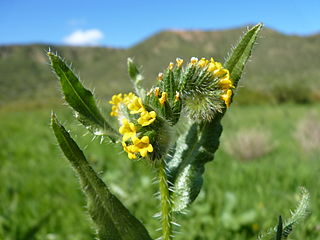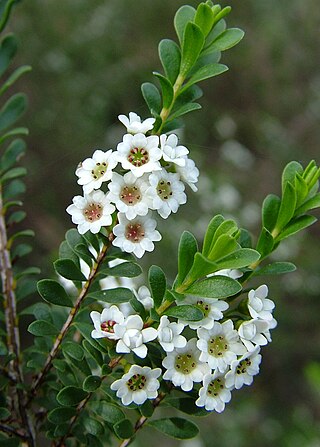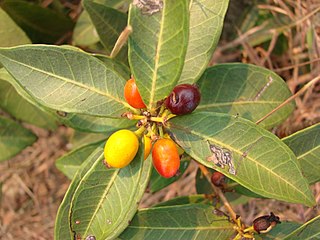Related Research Articles

Correa is a genus of eleven species of flowering plants in the family Rutaceae that are endemic to Australia. Plants in the genus Correa are shrubs to small trees with simple leaves arranged in opposite pairs, bisexual flowers with four sepals, four petals usually fused for most of their length and eight stamens.

The subclass Euechinoidea includes almost all living species of sea urchin, with fossil forms going back as far as the Triassic.

Prostanthera calycina, the West Coast mintbush, limestone mintbush or red mintbush, is a species of flowering plant that is endemic to the Eyre Peninsula in South Australia. It is a small, more or less prostrate shrub with aromatic, elliptic to oblong leaves and red flowers.
Ixora calycina is a species of flowering plant in the family Rubiaceae. It is endemic to Sri Lanka.
Palicourea calycina is a species of plant in the family Rubiaceae. It is endemic to Ecuador.
Ternstroemia calycina is a species of flowering plant in the family Pentaphylacaceae. It is endemic to Jamaica, where it is known only from Cockpit Country. It is considered endangered.

Lepechinia calycina is a species of flowering plant in the mint family known by the common name pitchersage or woodbalm. It is endemic to California, where it is a common plant in several different habitat types, including the chaparral plant community.

Correa calycina, commonly known as the South Australian green correa or Hindmarsh correa, is a species of tall, dense shrub that is endemic to a small area of South Australia. It has papery, oblong leaves and pendulous green flowers arranged singly on the ends of short side branches.

Ehrharta calycina is a species of grass known by the common names perennial veldtgrass and purple veldtgrass.

Amsinckia calycina, also known as hairy fiddleneck or yellow burweed, is a species of fiddleneck. It is native to Argentina and Chile and naturalised in Australia. It is an annual herb, growing to between 15 and 50 cm high and has pale yellow flowers. The species is poisonous to mammals.

Thryptomene calycina, commonly known as Grampians thryptomene, is a species of flowering plant in the family Myrtaceae and is endemic to Victoria in Australia. It is an erect or spreading shrub with oblong, elliptic or egg-shaped leaves with the narrower end toward the base, and white flowers with five stamens.
Calycina is a genus of beetles in the family Mordellidae, containing the following species:

Aristida calycina, commonly known as dark wiregrass, is a species of grass in the family Poaceae that is native in Australia.
Relhania calycina is a shrublet belonging to the daisy family. It is found in rocky Fynbos and Renosterveld vegetation, growing in rocky, loamy or sandy soil, in the Western Cape Province and Eastern Cape Province, South Africa.

Kydia is a genus of flowering plants in the family Malvaceae, found in the Indian subcontinent, southern China and Southeast Asia. Some sources consider it to be monotypic, with Kydia calycina the only species; certainly K. calycina is the best‑studied species, as it is widely exploited, even cultivated, for timber and fiber.

Kydia calycina is a species of flowering plant in the genus Kydia found in the Indian subcontinent, southern China and Southeast Asia. A fast‑growing, medium‑sized tree, it is widely exploited, even cultivated, for cheap timber and fiber.

Eugenia calycina, also known as savannah cherry, field cherry, Jabuti cherry, Grão de galo, cerejinha, cereja do cerrado, pitanga-vermelha, red pitanga, cherry of the Cerrado, and ca-ajaboti, is a flowering shrub in the family Myrtaceae. The specific epithet (calycina) comes from Latin calycinus, meaning having a notable calyx.
Suchtelenia is a monotypic genus of flowering plant belonging to the family Boraginaceae. It only contains one known species, Suchtelenia calycina(C.A.Mey.) DC.
Pultenaea calycina is a species of flowering plant in the family Fabaceae and is endemic to near-coastal areas in the south of Western Australia. It is an erect, spindly shrub with flat or more or less cylindrical, grooved leaves and yellow and orange flowers.
Cyanea calycina is a flowering plant in the Campanulaceae family. The IUCN has classified the species as critically endangered. It is native to the Hawaiian Islands. An example is being monitored with a plant cam.
References
- ↑ Mordellidae Species List at Joel Hallan's Biology Catalog. Texas A&M University, archived from the original on 7 October 2014, retrieved 8 August 2015